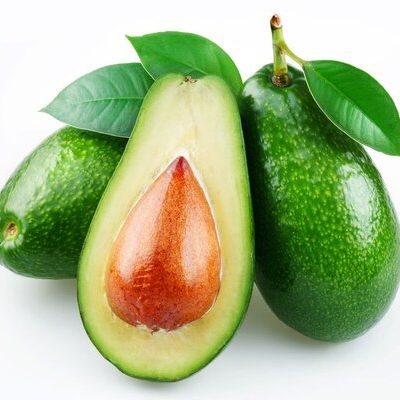
Avocado
What is an Avocado?
Avocado (Persea americana) is a tree fruit known for its soft green flesh, hard brownstone, and textured black peel. It is a unique fruit native to highland Mexico with several varieties. This buttery fruit lends itself to an array of sweet and savory dishes.
The top 7 most popular varieties of avocado are:
- Green gold
- Guatemalan
- Gwen
- Bacon
- Whitsell
- Zutano
- Hashimoto
Origin of avocado
The fruit originated in Mexico between 7,000-5,000 BCE and was a treasured food for the locals. Archaeologists discovered seeds from this fruit in the tombs of mummies in Peru dating back to 750 BCE. This fruit was later introduced to the West Indies, Jamaica, and the Philippines towards the end of the 16th century. This fruit got to the Dutch East Indies in 1750, and then Mauritius around 1780. Also, it began to be cultivated in Hawaii in 1825 and then later in California in 1833.
Following this, this fruit became popular in India after its introduction in 1892. Although this fruit made it to Singapore far before it got to India, it was never popular there. Avocados are likely popular in India, particularly in Madras and Bangalore, due to their sweetness. The purported health benefits of this fruit led to its introduction into different countries. Today, it has become a trendy food item, with cultivation springing up in almost every part of the world.
Function
The avocado is a versatile fruit, commonly used as a base for salads or poke bowls. Also, this fruit is a great topping for tacos, sandwiches, hamburgers, hot dogs. The fat in this fruit makes it ideal for crafting plant-based versions of desserts, such as cake, mousse or milkshakes.
Nutrition
A 100g serving of avocado contains:

This fruit contains some nutrients like vitamins B5, B6, C, E, and K, as well as folate and potassium. These fruits actually have more potassium than bananas and can help reduce blood pressure. Plus, this food offers plenty of unsaturated fatty acids, which makes it beneficial for heart health and aids the absorption of nutrients. Additionally, it has lots of fiber and may aid in weight loss. Not to mention, this fruit can help lower cholesterol levels.
Commercial production
Avocados grow in subtropical areas with fairly high rainfall and frequent mist. The ideal daily temperature ranges between 68°F-77°F. Additionally, this fruit has a reputation for being sensitive to water stress, so sufficient rainfall and supplementary irrigation might be desirable. Also, the tree’s branches must not touch each other to prevent the tree from dying. Finally, younger trees require balanced fertilizer while older ones prefer nitrogenous soil; however, no fertilizer should be given to the trees during the blooming period until the fruiting period. Just before the fruit is ripe, farmers harvest them to allow them to ripen on their way to market.
Application
Avocados can easily change color and become overripe. So it is advisable to keep the fruit in the fridge to slow the ripening. However, if you want the fruit to ripen faster, place it in a paper bag with a banana to speed up the process. The easiest way to open an avocado is to slice it down the middle as you turn the fruit around for a clean, full-body cut. Then, twist the two fruit parts in opposite directions to reveal the stone. To remove the stone, you can use a knife, but if the fruit isn’t ripe enough, use a spoon to avoid injury.
Avocado recipes
This fruit works well in sweet and savory dishes. Some popular recipes include:
- Black Bean and Avocado Burritos
- Avocado On Toast with Salmon
- Avocado Cream Sauce
- Seedy Arepas With Black Beans
- Avocado Egg Salad
- Vegan Chocolate Cake
FDA regulation
The Food and Drug Administration classifies this fruit as a raw agricultural commodity. Therefore, it regulates its growing, harvesting, packing and holding. Also, the FDA recommends that fresh-cut processors or manufacturers consider a preventive control program to minimize microbial food safety hazards potentially associated with fresh-cut produce.
References
“An Avocado a Day Is Good for Your Heart Health: Nutrition: UT Southwestern Medical Center.” Nutrition | UT Southwestern Medical Center, utswmed.org/medblog/avocado-a-day/. https://utswmed.org/medblog/avocado-a-day/
Morton, Julia. “Avocado.” Fruits of Warm Climates, Purdue University, 1987, hort.purdue.edu/newcrop/morton/avocado_ars.html.
